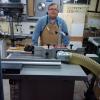Howdy,
I have essentially no woodworking experience. I've only done one project so far - the three tier inbox from the March issue of Woodsmith magazine - and made numerous mistakes, but learned a lot. However after spending $70 for nice hard maple and cherry wood for an inbox that I could have gotten made out of plastic from WalMart for $3 I decided to try and seek out some more affordable lumber for my next project.
That is when I noticed someone selling some left over red oak floorboards on Craigslist. This was just one old left over bundle of 19.5 sq ft for $20. So I got them. [Pictured below.] The face of the floorboard is 2.25" wide, but I'm planning to rip the tounge and groove parts off on the table saw and then run the boards through the jointer to square up the sides. After than I assume I'll only get about 1-7/8" usable width out of each board. Also they are 3/4" thick, but they have "stress relief" grooves on the bottom [pictured below], so I figure if I run them through the planner to make the board smooth on both sides I'll only end up with a 1/2" thick usable result. So, I am crazy to go through all this work to save some $ on lumber? And do you think I'll be able to get a usable result out of these floorboards, or am I on a fool's errand?
Assuming I can get descent square S4S red oak boards out of this process I am thinking I would like to try making a nightstand for this next project. After looking through some photo galleries on woodworking sites I found one that I like the looks of at http://finewoodworking.taunton.com/i...ht-stand-table [pictured below.] Now a few questions come to mind. Table tops usually seem to be thicker than 1/2", but that is all I will be getting out of the floorboards. If I edge glue the floorboards to make the top for the nightstand should that work OK? Or would I need to get some thicker wood to make like a frame around the top, breadboard they call it I think? And for the legs since I'll only have the 1/2" stock I will need to glue 3 or 4 pieces face to face. This is why I liked this particular design with the inlay strip because I thought I could put the inlay strip over each of the 2 or 3 seams where the boards are glued together for the legs. Is this a good idea, or would routing the groove at the glue joint be hard or cause a problem with the pieces glued together? And just from an looks standpoint do you think having 2 or 3 inlays like that running down the leg only 1/2" a part would look too "busy," or would it be OK?
As for the drawer, I'm not sure if I'll go buy walnut or just stick with oak, but I guess if I do the leg inlays then I should go with the same material as the inlays for the drawer front since it would look silly otherwise. However, I'm sure I won't be attempting dovetails yet, especially since I don't have any way to cut them. (I'm just using a community center woodshop for $3 a day, don't own any tools myself, and they don't have any fancy router bits for dovetails.) Anyway, so I think I'll probably try a box joint by cutting out on the table saw, or would anyone have a different recommendation? Also, does anyone know where to look on-line for how to build a drawer? Not the drawer itself, but how to support it inside the nightstand, and how to make it silde in and out properly? I don't want to buy drawer slides, just do normal wood-on-wood.
I'm looking forward to reading all replies, especially any tips or suggestions on how to use the floorboards or design considerations on using them to make the nightstand. Thanks!




 Reply With Quote
Reply With Quote








